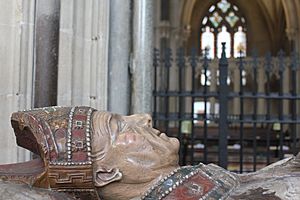Thomas Beckington facts for kids
Quick facts for kids Thomas Beckington |
|
|---|---|
| Bishop of Bath and Wells | |
 |
|
| Appointed | before 13 October 1443 |
| Reign ended | 14 January 1465 |
| Predecessor | John Stafford |
| Successor | Robert Stillington |
| Orders | |
| Consecration | 13 October 1443 |
| Personal details | |
| Born | c. 1390 Beckington, Somerset |
| Died | 14 January 1465 Wells |
| Denomination | Roman Catholic |
| Previous post | Dean of Arches |
Thomas Beckington (also spelled Beckynton; born around 1390, died January 14, 1465) was an important person in medieval England. He served as the Bishop of Bath and Wells and was a trusted advisor, or King's Secretary, to King Henry VI.
Contents
Thomas Beckington's Life
Early Years and Education
Thomas Beckington was born in a place called Beckington in Somerset, England. He went to school at Winchester and then studied at New College, Oxford. These were important schools for young men at that time.
Working for the King
After finishing his education, Thomas Beckington joined the Church. He held many important jobs within the Church. In 1423, he became the Dean of the Arches, which was a senior legal position. The next year, he became the Archdeacon of Buckingham.
Soon, Beckington started working more on government matters. He was sent on important trips for the king. In 1439, he traveled to Calais, a city in France that was controlled by England. In 1442, he went to visit Count John IV of Armagnac in France.
During this time, Beckington was also the secretary to King Henry VI. This meant he helped the king with letters and important documents. When he returned from his travels in 1443, he was given an even bigger job. He became the Lord Privy Seal, a high-ranking government official. He held this position until 1444.
Bishop of Bath and Wells
On October 13, 1443, Thomas Beckington became the Bishop of Bath and Wells. As bishop, he was in charge of the Church in a large area of England. He was known for building many structures in Wells and other places. He likely made changes to a rectory (a house for a priest) in Sutton Courtenay.
Beckington kept detailed records of his trips to France. One journal, written by him, described his journey to Calais. Another journal, written by someone who traveled with him, told the story of the trip to Armagnac. These journals give us a look into what life and diplomacy were like back then.
Thomas Beckington passed away in Wells on January 14, 1465.
His Resting Place and Legacy
Thomas Beckington is buried at Wells Cathedral. His tomb is quite unusual. It has two statues of him, one above the other. The bottom statue shows him as a decaying body, wrapped in a shroud. The top statue shows him dressed in his bishop's clothes.
When his tomb was opened many years later, people found that he was buried very simply. He had only one special item with him: his bishop's ring. This ring was later moved to a museum.
Beckington also played a big part in creating Eton College in 1440. This famous school was founded by King Henry VI. Beckington helped with the legal parts of setting up the school. Today, one of the dining halls at Eton College is named 'Bekynton' in his honor.
In a letter from 1449, Beckington wrote about the city of Bath. He mentioned that the famous healing waters of Bath were being used in a way that he found disrespectful by the people living there. He wrote that "by ... custom of the city, [the people] shamelessly strip them of their said garments and reveal to them to the gaze of bystanders." This shows us a bit about social customs of the time.
You can often spot a special symbol on buildings that Beckington helped build. This symbol shows a barrel and a flame. It's a clever play on his name, sounding like "beacon tun." One easy place to see this symbol is on Penniless Porch in Wells.
Images for kids
See also


